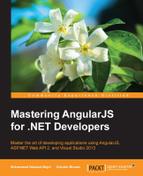Angular 2.0 was officially announced in ng-conference on October 2014. Angular 2.0 will not be a major update to the previous version, but it is a complete rewrite of the entire framework and will include major changes. This appendix is organized as follows:
- Why Angular 2.0
- Design and features of Angular 2.0
- AtScript
- Routing solution
- Dependency injection
- Annotations
- Instance scope
- Child injector
- Data binding and templating
AngularJS is one of the most popular open source frameworks available for client-side web application development. From the last few years, AngularJS's adaption and community support has been remarkable. The current AngularJS Version 1.3 is stable and used by many developers. There are over 1600 applications inside Google that use AngularJS 1.2 or 1.3. In the last few years, the Web has changed significantly, such as in the past, it was very difficult to build a cross-browser application; however, today's browsers are more consistent in their DOM implementations and the Web will continue to change.
Angular 2.0 will address the following concerns:
- Mobile: Angular 2.0 will focus on mobile application development.
- Modular: Different modules will be removed from the core AngularJS, which will result in a better performance. Angular 2.0 will provide us the ability to pick the module parts we need.
- Modern: Angular 2.0 will include ECMAScript 6 (ES6). ECMAScript is a scripting language standard developed by Ecma International. It is widely used in client-side scripting, such as JavaScript, JScript, and ActionScript on the Web.
- Performance: AngularJS was developed around 5 years ago and it was not developed for developers. It was a tool targeting developers to quickly create persistent HTML forms. However, over time, it has been used to build more complex applications. The Angular 1.x team worked over the years to make changes to the current design, allowing it to continue to be relevant as needed for modern web applications. However, there are limits to improve the current AngularJS framework. A number of these limits are related to the performance that results to the current binding and template infrastructure. In order to fix these problems, a new infrastructure is required.
In these days, the modern browser already supports some of the features of ES6, but the final implementation in progress will be available in 2015. With new features, developers will be able to describe their own views (template element) and package them for distribution to other developers (HTML imports). When in 2015 all these new features are available in all the browsers, the developer will be able to create as many endeavors for reusable components as required to resolve common problems. However, most of the frameworks, such as AngularJS 1.x, are not prepared, the data binding of the AngularJS 1.x framework works on the assumption of a small number of known HTML elements. In order to take advantage of the new components, an implementation in Angular is required.
